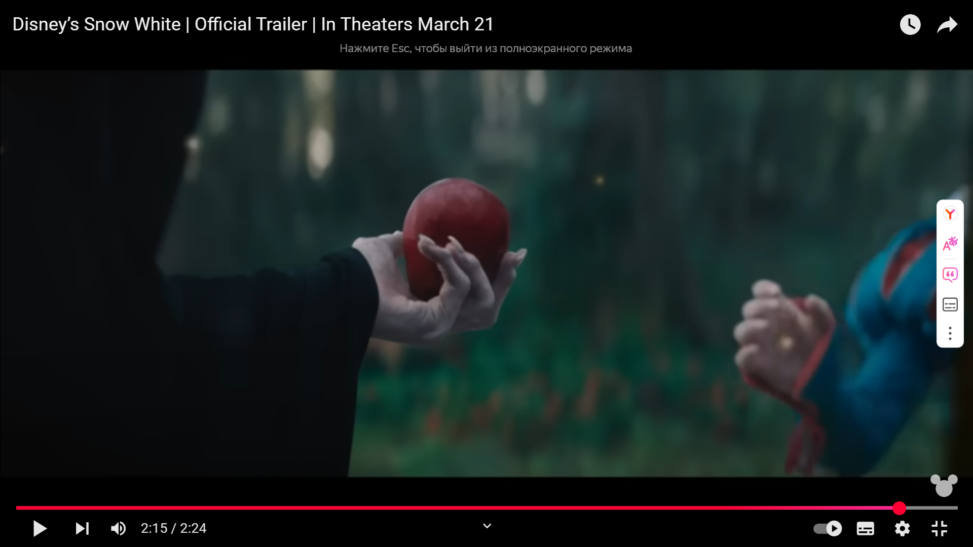Analysis of the Poisoned Apple Scene in Snow White (2025)
Hollywood action movies rely significantly on the image of violence to direct their narratives and engage viewer. The 2025 film Snow White, an adaptation by Disney, includes traditional fairy tale elements, modernizing its visual and narrative style at the same time. One of the most iconic moments in the story is the transformation of Evil Queen and her offer of poisoned apple to Snow White. This scene is one of the most crucial in film’s sequence adding tension, deception and coming danger. In this analysis I will examine mise-en-scene scene, its montage, camera movements and its role in action film genre.
The scene begins in a dark forest, highlighting the contrast between Queen’s dark hooded robe and the bright poisoned apple. The Queen’s pale hand reached towards Snow White, whose costume differs by bright blue and red tones, visualy marking her innocence. The depth of field keep the background blurred making the viewer focus on queen’s hand and apple. The lighting is dim with natural light coming through the trees adding ominous atmosphere to the scene. The shadows that cover the queen’s face strength her threatening presence (Mulvey, 1975)
The montage and camera movements in this scene follows modern trend of action films – quick cuts and different camera angles to highlight the tension. Withing the one minute sequence, there are close to 20 montages, including close ups of Snow White’s hesitant face expression and the queen’s smile, offering apple. The camera movements are largely hand held, creating sense of instability that illustrates into growing fear and uncertainty. However, the final shot, when Snow White takes the apple is a steady medium shot, highlighting the importance of the moment (Bordwell, 2006)
Like many Disney adaptations, Snow White keeps traditional dynamic of a young, beautiful female protagonist facing envy of jealous older woman. The transformation of the Queen into an old crone shows the comparison of youth associated with purity and age with corruption. It shows broader patterns in Hollywood, when female antagonist is often displayed by vanity and fear of losing their youthful beauty (Doane, 1991). In terms of race, Disney’s decision to cast a Latina actress as Snow White leaded to debates about representation, but the Queen remains to a Eurocentric aesthetic.
Moreover, Snow White’s focus on traditional beauty standards represents a trend in Hollywood narrative. Female characters in action films are often placed in strict frames, where physical appearance shows moral status. The Queen’s transformation into weak old woman not only signals her villainy, but strength the association between aging and malice. This pattern is shown in other modern films, where young heroines resist older adversaries. By visually contrasting Snow White’s princess appearance with the frightening Queen, the film connects innocence with beauty and malice with desctruction.
The movie doesn’t address the problem of abilities, but the transition of Wueen into physically weak figure strengths the narrative. The use of violence, tense montage and visually bright imagery in Snow White corresponds with common themes in modern action films. As King (2000) notes, modern action films often use rapid editing to increase viewer engagement. Additionally, the film uses the trope of “imminent danger” when the character is put in danger by untrustworthy figure, a narrative commonly used in the horror and thriller genres (Neill, 1999)
According to Box Office Mojo, Snow White (2025) made significant box office profits in its opening weeks. Although surrounded in debates of casting and script changes, the film performed well internationally. However critics noted that its darker tone and heavy sequences marked a shift from charm of the original film.
The image of tensioned and heavy moments in such films, as Snow White contributes to ongoing debates about psychological impact on viewer. The research by Bandura (2001) proves that repeated scenes of violence on screen can decrease sensivity of viewer and shape their perception of real danger. Although the scene in Snow White doesn’t have direct physical violence, it is based on horror and anticipation of harm that can be distressing to younger audience.
The poisoned apple scene in Snow White (2025) demonstrated the key elements of modern holywood filmmaking, including montage based on tension, mise-en-scene and the use of violence. Although the film stick to classical narratives, its adaptation into an action based film style places it into broader genre that relied on tension. By analyzing the scene through representation of violence, montage techniques we get a deeper understanting of its role in modern film culture.
References
• Bandura, A. (2001). Social cognitive theory of mass communication. Media Psychology, 3(3), 265-299.
https://research.ebsco.com/c/amz5ui/search/details/io7task2cb?limiters=FT1%3AY&q=Bandura%2C%20A.%20%282001%29.%20Social%20cognitive%20theory%20of%20mass%20communication.%20Media%20Psychology%2C%203%283%29%2C%20265-299.
• Bordwell, D. (2006). The Way Hollywood Tells It: Story and Style in Modern Movies. University of California Press.
https://research-ebsco-com.ezproxy.tru.ca/c/amz5ui/search/details/24352dhdxj?isDashboardExpanded=true&limiters=FT1%3AY&q=PS%20%22WAY%20Hollywood%20Tells%20It%3A%20Story%20%26%20Style%20in%20Modern%20Movies%2C%20The%20%28Book%29%22
• Doane, M. A. (1991). Femmes Fatales: Feminism, Film Theory, Psychoanalysis. Routledge.
https://research-ebsco-com.ezproxy.tru.ca/c/amz5ui/search/details/zvrru7rl4b?limiters=FT1%3AY&q=Doane%2C%20M.%20A.%20%281991%29.%20Femmes%20Fatales%3A%20Feminism%2C%20Film%20Theory%2C%20Psychoanalysis.%20Routledge.
• King, G. (2000). Spectacular Narratives: Hollywood in the Age of the Blockbuster. I.B. Tauris.
https://research-ebsco-com.ezproxy.tru.ca/c/amz5ui/search/details/o5hwowmarf?limiters=FT1%3AY&q=King%2C%20G.%20%282000%29.%20Spectacular%20Narratives%3A%20Hollywood%20in%20the%20Age%20of%20the%20Blockbuster.%20I.B.%20Tauris.
• Mulvey, L. (1975). Visual Pleasure and Narrative Cinema. Screen, 6.
https://academic.oup.com/screen/article-abstract/16/3/6/1603296?redirectedFrom=fulltext&login=true#no-access-message#no-access-message
• Neale, S. (1999). Genre and Hollywood. Routledge.
https://www.routledge.com/Genre-and-Hollywood/Neale/p/book/9780415026062?srsltid=AfmBOooRjbIyFjFNEUr11FRDvdqrpIMOEaFMknaIl44KkW3bjULoeZKO


Fadekemi Oyebade
Roman Trofimov ‘s analysis of the poisoned apple scene in Snow White (2025) shows us a good look at how modern filmmaking techniques like camera movements, quick cuts, handheld cameras, and visual contrasts are used to create tension and highlight the themes of innocence versus evil.
The assessment is well written . Roman addressed the broader pattern in Hollywood, where aging women villains are often portrayed with negative connotations, reinforcing societal concerns about beauty and youth. The description points out the Queen’s transformation and her connection to typical Hollywood portrayals of female villains, but it doesn’t explore if this film challenges or changes this idea.
While the analysis captures the scene’s tension and cinematic techniques, it overlooks some important aspects. The transformation of the Queen into a crone is not just a superficial visual trope, it also represents a deeper psychological shift, reflecting her obsession with power and control. The analysis does a good job connecting the scene’s style to modern action films. Generally I agree with the analysis and assessment. The image described is an accurate illustration, it matches the description. The scholarly sources are precise.